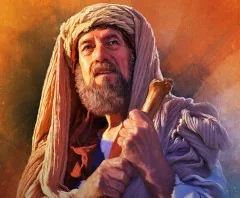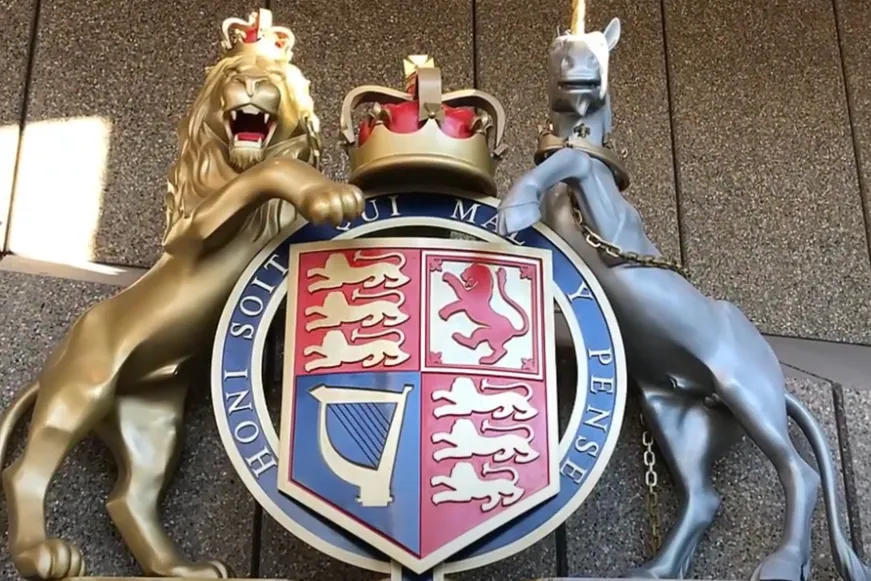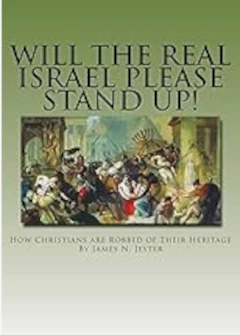Little Known History - Part 1
Copied from the sermon notes of Pastor Don Elmore
October 27, 2024
Scripture Reading: Deuteronomy 24:7
7) “If a man be found stealing any of his brethren of the children of Israel, and maketh merchandise of him, or selleth him; then that thief shall die; and thou shalt put evil away from among you.”
It is amazing how many things we were not told in our high school American History classes. We were being a little bit indoctrinated rather than educated. It has gradually, throughout the years, been more of an indoctrination rather than an education. I think that it was accomplished partly in high school but at the university it was a lot worse. I even had a Communist professor at one of the universities that I attended.
Irish slavery in America and the West Indies spanned for over 180 years. It occurred both before and during black slavery in the British colonies. In the 1600s, Irish slavery was paramount as England captured over one million Irish inhabitants and carted them off as slaves or indentured servants to help populate the new territories of Great Britain. And in addition, President Thomas Jefferson sent two of his newly created armed forces (Navy and Marines) to help end white slavery. But there is something very strange about this event. There is nothing of this episode in the American high school history books.
This sermon is about a few of the things that I missed being taught in both high school and college. Maybe you did or maybe you didn’t learn this. But I hope that you find this sermon beneficial. We will begin by asking these questions: Who or what was born on these dates?
- November 10, 1483?
- November 10, 1775?
- November 10, 1942?
- November 10, 2024?
- November 10, 2067?
Answers:
- Martin Luther:Birthday of this Roman Catholic priest who started the Protestant Reformation which set the world afire with a world changing revolution.
- United States Marine Corps:Birthday of the founding of the Marines that occurred 292 years after Martin Luther’s birth.
- My birthday: Occurred 459 years after the birthday of Martin Luther and 167 years after the founding of the Marine Corps.
- My 82nd birthday: Will occur 249 years after the founding of the Marines.
- My 125th birthday: 292 years between Martin Luther’s birthday and the founding of the Marines and 292 years between the founding of the Marines and my 125th birthday. I don’t think that I will make this one.
So, what has happened in the world in these 541years since Martin Luther’s birthday till now?
- October 31, 1517: Luther nailed his 95 grievances on the Wittenberg Castle Church door that began the Protestant Reformation.
- October 31, 2033: The founding of the Marines is the midpoint (1775) between Luther’s 95 thesis (1517) and this date (2033).It will happen in just nine more years. The midpoint will be 258 years. Maybe I will make this one.
The Reformation was caused due to the grievances that the people had towards the unjust practices of the Catholic Church, like:
1) Indulgences: The sale of indulgences, which were certificates that forgave sins in exchange for money.“The love of money is the root of all evil” (1 Timothy 6:10a).
2) Church power: The church’s excessive wealth and power, and the Pope’s extravagant authority over the church and European nations.
3) Church corruption: There were problems with the church, including priests who were not well-educated and some higher leaders, like cardinals and bishops who were corrupt.
4) Bible authority: The authority of the Bible was challenged over the human institution in matters of faith.
5) Church practices: Objections were made about the practice of clerical celibacy and other situations.
Because of the invention of Gutenberg’s printing press (mid 1400s), the means were provided for the speedier dissemination of religious materials than what was available in the past. The initial movement in Germany diversified, and other reformers such as Huldrych Zwingli, William Tyndale, John Knox, John Hus, John Wycliffe, and many others, with somewhat different theologies, arose and reformation thought spread throughout Europe.
In general, the Reformers argued that salvation in Christianity was a completed status based on faith in Jesus alone and not a process that could involve good works, as in the Catholic view. Protestantism also introduced new ecclesiology and eschatology, including the idea that the Pope was the Antichrist.
This view of the main leader of the Catholic Church caused an uproar among its leaders. This was one of the new Protestant beliefs that led to the formation of the Counter-Reformation. It was the effort by the Catholic Church to either stop or greatly lessen the influence of the Protestant Reformation.
The organization that led the Counter-Reformation was the Society of Jesus or the Jesuits. This organization was approved by the Pope in September 1540 (23 years after the beginning of the Protestant Reformation)and was started by Ignatius Loyola, Peter Faber, Francis Xavier and four other Catholics.
[Let’s divert for a little bit and talk about the Athenaeum. The Athenaeum was a small Catholic college in Cincinnati, Ohio. The Society of Jesus (the Jesuits) took control of the Athenaeum in 1840, and the name was changed to St. Xavier College in honor of the 16th century Spanish Jesuit missionary, St. Francis Xavier who, like the founder of the Jesuits, Ignatius Loyola, was a Spanish Navarrese. [Spanish, Portuguese, Italian, and Jewish (Sephardic)]: habitational name from Navarre, a largely Basque-speaking region now divided between Spain and France, but in the Middle Ages an independent Basque kingdom.
Its capital city, Vitoria-Gasteiz, was about 100 miles from the city of Pamplona, which is where the “running of the bulls” occurs every July 7th-14th during the San Fermin Festival.
Image
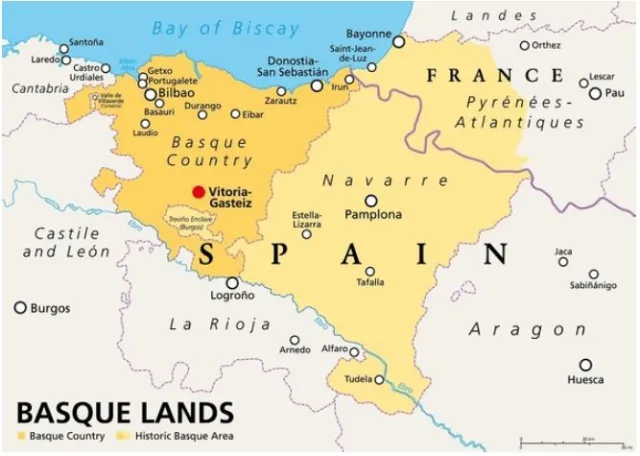
While studying at the University of Paris, Ignatius Loyola became a very important influence on his roommate—Francis Xavier. In August of 1534, Xavier joined Ignatius and five other companions in planning the Society of the Jesuits, whose main purpose was the elimination of the Protestant Reformation’s influence.
In 1537, the seven travelled to Italy to seek papal approval for their new organization. Pope Paul III gave them a commendation and permitted them to be ordained priests. These initial steps led to its official founding in 1540.
Xavier’s missionary travels took him to many places around the world. He traveled from Rome to Lisbon, Portugal and then to India. Along the way, he assisted in many previously established missions; including those in Mozambique and Melindi (Kenya) Africa, Socotra (an island off the coast of Somalia), and Goa (a district on the west coast of India), and Malaysia and Indonesia.
In 1549, Xavier began the first Christian mission in Japan where he served in the country for over two years. In 1552, he set sail to begin the first Catholic mission in China. When he arrived, however, he was not allowed to disembark on the mainland. For three months, he waited on an island off Canton while trying to enter the country. (China did not have an open border). He died on the island of an acute illness at the age of forty-six. Francis Xavier was canonized by Gregory XV on March 12, 1622, at the same time as Ignatius Loyola.
St. Xavier ranks among the greatest missionaries in Roman Catholic history. Historians place the number of baptisms that he performed between 30,000 to 100,000 people.
So, Xavier University and St. Xavier High School in Cincinnati, Ohio are named after this Jesuit who was one of the founders who attempted to stop the influence of the Protestant Reformation.]
Back to our main topic. After the Jesuits were formed, they were commissioned by the Pope to develop a new interpretation of Scripture that would counteract the Protestant application of the Bible’s Antichrist prophecies to the Roman Catholic Church. Francisco Ribera (1537-1591), a brilliant Jesuit priest agreed to do the job. Ribera interpreted that the Antichrist, instead of being the Pope, would be an evil person received by the Jews in the future who would rebuild Jerusalem. He said that the Christians would be raptured out of the earth at this time. This disagreed with what Protestant reformers had taught about the Antichrist. The result of Ribera’s work was a twisting and maligning of prophetic truth.
For almost 300 years this doctrine of a future Antichrist remained largely inside the realm of Catholicism. But in the early 1800s it got a hold of some Protestants in England, and it soon spread to America and to its Protestant Churches. It is now called dispensationalism or futurism.
There were civil wars, wars between nations, assassinations, betrayals, coups, fights between religions, defeated opposing religious members captured as slaves and sent to the Caribbean islands and North America, millions of Africans were captured by black enemies and sold as slaves to Arabs and Jews, Muslim pirates capturing crews off ships and coastal villages and cities making them slaves, etc.
Question: For ten years the United States paid over six hundred thousand dollars as an initial payment plus an annual payment which was about 20% of its entire financial budget to the ________ ________.
To whom did the United States pay this much money?
UNITED STATES MARINECORPS
We sang the United States Marine Corps hymn in elementary school. I started kindergarten in 1947. We sang this anthem, because, I guess, World War II ended only two years previously. But I always wondered about the second line in the hymn:
“From the shores of Tripoli.”
Where was Tripoli? Why were the Marines fighting there? But I finally found my answers recently. The United States Marines fought to free and prevent any more white slaves from being taken off American ships and from the coastal areas of southern and western Europe.
The Marines were sent to Tripoli, by the third president of the constitutional United States, Thomas Jefferson, in the first foreign war in the country’s young history. It was the War against the Barbary pirates. The Barbary pirates from North Africa’s Barbary coast would capture American ships and keep them, their merchandise, and hold the sailors as slaves. The pirates would also demand ransom and tribute payments that the United States could not afford to pay. They did this to all ships from all the nations that sailed the Mediterranean Sea and others on waters, like the Atlantic, close by the northern African shore.
The Barbary pirates were a band of privateers who served as part of the naval forces of the Ottoman Empire, a huge, multi-ethnic empire that spanned throughout southern Europe, northern Africa, and the Middle East. The Barbary pirates operated in teams from ports in North Africa such as Algiers, Tunis, and Tripoli. Their reign of terror in the Mediterranean Sea and Atlantic Ocean lasted about 250 years from the late 1500s to the early 1800s. By the 1700s, the Barbary pirates had become so fearsome that many nations, including the United States, for some time, agreed to pay them an annual ransom to ensure their trading vessels sailed safely in the Mediterranean.
The Barbary pirates frequently raided seafaring vessels and coastal towns. They often captured white people in Italy, Spain, France, and Portugaland sold them as slaves in Morocco and/or Algeria. They were other less frequent raids in England, Scotland, Wales, Ireland, the Neverlands and Iceland where they captured additional white slaves.
Some of the slaves were forced to man the oars of the pirate galleys and suffered horrible abuses such as lashings and deprivation of food. Such raids terrorized coastal populations and caused many villages to be abandoned completely out of fear.
Image
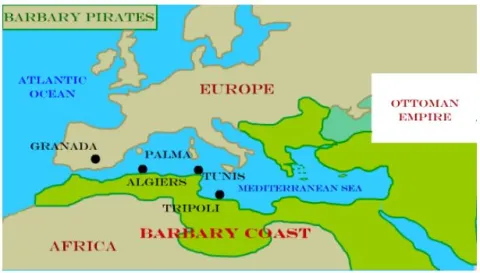
One big economic negative of the War of Independence for the colonies, was that since 1775, the British fleets had stopped protecting American ships after their defeat in the American Revolution. This resulted in the birth of the United States Navy on October 13, 1775, by the Continental Congress to fight against the problems caused by the Barbary pirates. And under the Presidency of George Washington merchant shipping came under threat while in the Mediterranean Sea by Barbary pirates from four North African States.
Image

This leads us to the answer to the previous question: For ten years the United States paid the Barbary pirates an initial payment of $642,500 plus an annual payment which was about 20% of its financial budget. Finally, under America’s third constitutional president, Thomas Jefferson, refused to pay the annual payment which had risen to $225,000 by the end of 1800.
There is a little bit of information which is not mentioned in most articles about the war, but the ships captured by the Barbary pirates were financed by the National Bank of the United States, which was a usury bank, which would have caused an economic collapse in the nation if the pirating could not be stopped. So, war was declared against the Barbary pirates. Another war was promoted by the usury banks owned by Jews.
UNITED STATES VS. THE BARBARY PIRATES
The problem of slavery received a new meaning when white American sailors were enslaved by the Barbary pirates of North Africa. The hostages were kept in leg irons, chained to pillars, or locked in a rat-infested prison. Some American captives died of the bubonic plague; others went insane.
Major powers like Britain and France tolerated the “Barbary pirates” because they raised the shipping costs of potential competitors, such as Denmark, Holland, Portugal, and the United States:“ The love of money is the root of all evil” (1 Timothy 6:10a).
In a bid to free these white American slaves, the Continental Congress decided to send a man to negotiate with the leader of Algiers for release of Americans prisoners and for safe passage of American ships in the Mediterranean. The leader of Algiers demanded $3,000 ransom per hostage, twice as much as he asked of other nations. The representative of the United States returned home in 1789 without securing a treaty.
The two wars fought by the United States against the Barbary pirates were known as the First Barbary War (primarily against Tripoli, 1801-1805) and the Second Barbary War (primarily against Algiers, 1815).
After Thomas Jefferson became president of the United States in March 1801, he sent a United States Navy fleet, along with the Marines, to the Mediterranean to combat the Barbary pirates. The fleet bombarded numerous fortified cities in present-day Libya, Tunisia, and Algeria, ultimately extracting concessions of safe conduct from the Barbary states and ending the first war.
Later, during the War of 1812, with the encouragement of the United Kingdom, the Barbary pirates resumed their attacks on American vessels. Following the conclusion of the War of 1812 and America’s peace with Britain, James Madison, Jefferson’s successor, directed military forces against the Barbary states in the Second Barbary War. Lasting only three days, the second conflict ended the need for further tribute from the United States, granted the United States full shipping rights in the Mediterranean Sea, and significantly reduced incidents of piracy in the region.
SHORT HISTORY OF THE BARBARY PIRATES
In the late 1500s and early 1600s, there were around 35,000 European white slaves held throughout this time on the Barbary Coast. The greatest number were sailors, taken with their ships, but a good many were fishermen and coastal villagers. Out of all these, the British captives were mostly sailors, and there were unfortunate inhabitants of these countries, by pirates who raided the coasts of… Valencia, Andalusia, Calabria, and Sicily:
| Valencia | Andalusia | Calabria | Sicily |
... so often that eventually it was said that there was no one left to be captured any longer.
White slaves in Barbary were generally from impoverished families. There are no records of how many men, women and children were enslaved, but it is possible to calculate roughly the number of fresh captives that would have been needed to keep populations steady and replace those slaves who died, escaped, were ransomed, or converted to Islam. On this basis it is thought that around 8,500 new slaves were needed annually to replenish numbers -- about 850,000captives over the century from 1580 to 1680.
By extension, for the 300 years between 1500 and 1800, the figure could easily have been as high as 2,550,000 --this is only just over a fifth of the Africans taken as slaves from 1500 to 1800, but a considerable figure, nevertheless. White slaves in Barbary had almost as little hope of buying back their freedom as the Africans taken to Brazil, the Caribbean islands, and North America: most would end their days as slaves in North Africa, dying of starvation, disease, or maltreatment.
As a side note, between 1525 and 1866, 12.7 million Africans were shipped to the colonies of America, the Caribbean islands and Brazil. Where do you think that the African slaves were transported to? Here is where they went:
- Brazil:5.86 million,
- Britain (Caribbean islands):3.3 million,
- France (Caribbean islands):1.4 million,
- Spain (Caribbean islands):1.1 million,
- Netherlands (Caribbean islands),550,000,
- Colonies of America:388,000,
- Denmark (Caribbean islands): 111,000.
In almost three and one-half centuries, only 388,000 black slaves from Africa reached the colonies of America with another 65,000 who came over to America from the Caribbean islands after a short stay there. So, America took a total of only 453,000 black slaves from Africa:3.5% of all the African slaves! And from 1525 to 1830, more white slaves were taken to the Barbary coast than twice the black African slaves to America.
The American Defamation League and the Southern Poverty Law Center are two of the largest Jewish groups that are against Christianity. They kept secret the fact that it was mainly the Jews who were the leading traders of slaves in America and other parts of the world. The Jews were the owners of the ships that transported the slaves from Africa to South America, the Caribbean Islands and to North America. The Jews also owned the auction houses where the slaves were traded. Many of the Jews also owned many of the plantations where the slaves were used to plant, weed, and harvest a host of plants.
And the white slaves in Barbary were mostly used to row the pirate galleys in the pursuit of loot (and more slaves), worked so strenuous that thousands died or went mad while chained to the oar. During the winter these white slaves worked on state projects, quarrying stones, building walls or harbor facilities, felling timber and constructing new galleys. The slaves received one change of clothing every year. Those who collapsed on the job from exhaustion or malnutrition were typically beaten until they either got up or fatally expired on the ground.
The Muslim leader also bought most female captives, some of whom were taken into his harem, where they lived out their days in captivity.
Many other slaves belonged to private parties. As they aged or their owner’s fortunes changed, slaves were resold, often repeatedly. The unluckiest ended up stuck and forgotten out in the desert, in some sleepy town such as Suez, or in the Turkish sultan’s galleys, where some slaves rowed for decades without ever setting foot on shore.
Eventually priests began to negotiate ransom for the release of the slaves. Europeans sometimes attempted to buy their people out of slavery, but no real system emerged before 1640. Then the attempts became more systematic and were sometimes state subsidized, as in Spain and France. Almost all the actual work, however, from collecting the funds, to voyaging to Barbary, to negotiating with the slave owners there, was carried out by clergy.
Parish churches too, all over Spain and Italy, kept locked collection boxes marked for the poor slaves, with clerics constantly reminded their wealthier parishioners to include ransoming societies in their wills. Ransoming slaves was promoted as being one of the best of the charitable works a Catholic could perform, since slaves were ideal victims; their only fault, their crime, is recognizing Jesus Christ as the most divine Savior and of professing Him as the True Faith.
By the 1700s, the ransom orders had significantly reduced slave populations in Barbary, eventually even inflating slave prices, as more cash chased fewer captives. Compared to Catholic Europe, Protestant states could be lax and disorganized in freeing their subjects. Thousands of Dutch, Germans and British languished for years in the chains of Barbary, without the aid of organized clergy or state funds for their release.
UNITED STATES MARINES HYMN
“From the Halls of Montezuma
To the shores of Tripoli;
We fight our country’s battles
In the air, on land, and sea;
First to fight for right and freedom
And to keep our honor clean;
We are proud to claim the title
Of United States Marine.
Our flag’s unfurled to every breeze
From dawn to setting sun;
We have fought in ev’ry clime and place
Where we could take a gun;
In the snow of far-off Northern lands
And in sunny tropic scenes;
You will find us always on the job
The United States Marines
Here’s health to you and to our Corps
Which we are proud to serve;
In many a strife we’ve fought for life
And never lost our nerve;
If the Army and the Navy
Ever look on Heaven’s scenes;
They will find the streets are guarded
By United States Marines.
The opening stanza of the hymn tells of when in 1845, the United States launched the Mexican American War to seize Mexican lands. In September 1847, United States Marines and Army troops fought Mexican forces defending Mexico City. The Americans captured Chapultepec Castle; a historic site also known as the Halls of Montezuma. The victory effectively ended the war.
The second line tells of the war with the Barbary pirates. I didn’t learn about this conflict in school; elementary, middle, high or college, of the war (the first war in Unites States history) that was fought by the United States against the Barbary Pirates. I didn’t learn either about the small number of African slaves that the United States accepted. Why is this? Do you think it has anything to do with racism that is promoted in the nation’s schools?
For two hundred fifty years, the Barbary pirates (the Ottoman Empire, Muslims) captured over one million white people who were either:
- Sailors and crew members who were from many ships from many nations, or
- People who lived on coastal towns in nations along the northern coasts of the Mediterranean Sea and coasts of the Atlantic Ocean.
In the middle of this time, the British had several civil and religious wars, and they eventually ganged up on the Irish. They deported over a million Irish to their newly possessed territories in the New World that needed population to farm the plantations.
In the ten-year-period, 1651-1660, there were more Irish slaves in the American colonies, than non-slave colonists. And in the Caribbean islands, most slaves in the 1600s were Irish slaves, not black slaves. From the century, 1600-1700, more Irish captives were sold as slaves than black Africans.
A quick review of some of the worst times in Irish history:
- In 1612, tens of thousands of Irish were sold to Brazilian plantations, many owned by Jesuits.
- Between 1629 and 1632, many Irish slaves were sent to Guiana, Antiqua and Montserrat. By1637, Montserrat contained 67% of Irish slaves as its population.
- In 1649, the year the English king was executed, Oliver Cromwell began a campaign of terror in Ireland. All captured soldiers were sold into slavery.
- In 1650, 25,000 Irish were sold to planters in St. Kitts, Nevis and other Leeward islands in the Caribbean.
- During the 1650s, over 100,000 Irish children, generally from 10 to 14 years old, were taken from their parents, and sold as slaves in the West Indies, Virginia and New England.
- In1652, Cromwell instigated the Ethnic Cleansing of Ireland. He ordered that the Irish were to be transported overseas, starting with 12,000 Irish prisoners sold to the Caribbean Island of Barbados.
- In 1655, 82,000 Irish were sold to Barbados, Jamaica, Antigua, Nevis, Montserrat, and Virginia.
In 1656, Cromwell’s Council of State ordered that 1000 Irish girls and 1000 Irish boys be rounded up and taken to Jamaica to be sold as slaves to English planters.
The reason Irish slaves were reduced in the 1700s in America was the fact that Malaria was brought to the nation from Africa. The African mosquito, which spread the disease, survived in the warm waters of the Southern states. Blacks were protected from Malaria because they had sickle cell, which the Whites lacked. Otherwise, free whites, slave whites, and white indentured servants would have supplied all the labor needed.
The black slaves taken in Africa and shipped all over the world was the result of black tribes capturing other blacks and selling them to Arabs and Jews who were the merchant men. No white men could live in Africa because of Malaria for more than a year. In fact, there were as many crew members who died on the ships as the slaves they were transporting across the ocean, because of Malaria. The myth that whites came to Africa and captured slaves is untrue and is propagated in schools for political reasons. Selling black slaves to other people is the fault of blacks who captured other blacks.
Here is what Herbert L. Byrd, Jr. wrote in his book, “Proclamation 1625; America’s Enslavement of the Irish.”
“When one thinks of slavery in America, the only thought that comes to mind is Africans picking cotton in the fields of America. What many Americans don’t know is that the Irish preceded the Africans as slaves in the early British colonies of America and the West Indies. They toiled in the tobacco fields of Virginia and Maryland and the sugar cane fields of Barbados and Jamaica.
For over 179 years, the Irish were the primary source of slave labor in the British American colonies. Proclamation 1625 is the unveiling of the true and untold history of slavery in America. King James I’s Proclamation ordering the Irish be placed in bondage opened the door to wholesale slavery of Irish men, women and children. This was not indentured servitude but raw, brutal mistreatment that included being beaten to death.
The Irish were forced from their land, kidnapped, fastened with heavy iron collars around their necks, chained to 50 other people and held in cargo holds aboard ships as they were transported to the American colonies…The Irish and African slaves were housed together and were forced to mate[against God’s law]to provide the plantation owners with the additional slaves they needed. [“The love of money is the root of all evil.” (1 Timothy 6:10a).]
The British abolished slavery in 1833. This act emancipated the Irish slaves in the British West Indies. America abolished slavery in 1865.”
Here are a few of the things that I never learned in school:
- Jesuits were the society of the Catholic church whose purpose was to destroy the influence of the Protestant Reformation.
- The Protestant Reformation has been nullified because most of the church world is now Catholic/universal.
- Americas first war was with the Barbary Pirates during the term of Thomas Jefferson.
- Arabs have been the most involved, of all the people of the earth, being in the slave trading business for many, many centuries.
· Brazil received about 14 black slaves for every one that found their home in the North American colonies.
· The Caribbean islands provided more economic benefits than the American colonies in 1770-1780s.
· There were more Irish slaves in America for the years 1651-1660 than the colonists.
· The islands of Barbados, Montserrat, Antigua, Nevis, St. Kitts, St. Croix, Jamaica, etc., and several of the colonies in America were where there were more Irish slaves than black slaves for many years.
· Whites didn’t go to Africa and capture the black slaves. Blacks captured other blacks and sold them to Arabs and Jews who sold them to the whites.
My mother’s father, Eugene Michael Richardson, was an Irish Catholic, who was born and lived in Kenton County, Kentucky. My mother’s mom, Francis Spanton, was born in Covington, Kentucky. She was a Southern Baptist. In those days, anyone marrying a Catholic, had to sign papers that their children would be baptized (as infants) and raised as Catholics. My grandmother would not marry my grandfather because of this Catholic ritual. She threw hot water on the priest who came to her house to talk to her about this situation. My grandfather decided that he wanted to marry my grandmother anyway. So, he married my grandmother, and his Catholic family disowned him. His family was well off financially, and this put him and his new family in a financial pinch. There is a road which has their name on it that goes through the area where they used to live— “Richardson” road.
If they give reparations to black people who are the descendants of individuals who have been slaves (over 200 years ago), I will do more investigating. Were my Irish grandfather’s ancestors’ slaves? May God continue to bless what Martin Luther wrote at the end of his life.
Deuteronomy 24:7:
7) “If a man be found stealing any of his brethren of the children of Israel, and maketh merchandise of him, or selleth him; then that thief shall die; and thou shalt put evil away from among you.”
In 1691, after the defeat of the deposed Catholic King James II of England, the Jacobites became a fresh supply of captives ready to be sold as slaves for over a century and a half. Irish, men, women, and children—a policy of ethnic cleansing—would exist until 1839, when a bill was passed in England forbidding Irish slave trade.
To be continued.
Blessed be the LORD God of Israel.

